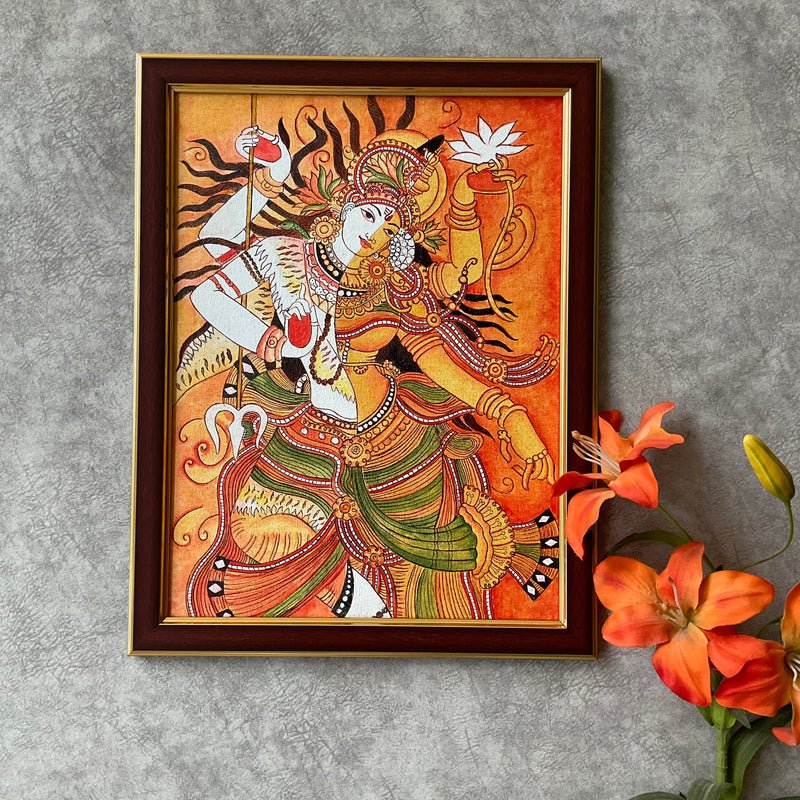In the serene landscapes of Kerala, an age-old art form blooms on temple walls: Kerala Murals Mythology in Wall Art. This visual storytelling technique, dating from the 8th–12th centuries CE, weaves mythical narratives directly into stone and plaster surfaces, immortalizing gods, goddesses, epics, and everyday symbolism. Today, while the tradition of temple murals thrives, contemporary artists also adapt these stories into modern homes—extending tradition beyond sacred precincts.
1. Origins of Kerala Murals
The tradition began as frescoes painted on the sanctum walls of temples (Shrikovils), reaching its apex under royal patronage between the 9th and 12th centuries CE .
- Earliest relics appear in Thirunandhikkara Cave Temple, believed to date from the 8th century .
- These murals are derived from Sanskrit treatises like Chitrasutra, guiding composition, iconography, and spiritual narrative en.wikipedia.org.
2. Mythic Narratives on Stone
Kerala murals serve as visual scriptures, bringing stories from the Ramayana, Mahabharata, Puranas, and tales of Shiva, Krishna, Ganesha, and Devi .
Figures are stylized—figures lush, faces serene—with flora and fauna weaving through scenes to deepen context .
Common pigments include natural hues: saffron-red/yellow, green via indigo, white lime, and black soot en.wikipedia.org.
3. Technique & Symbolism
Traditional murals are created through a four-step process :
- Lime-and-sand plaster
- Fine sketching
- Application of panchavarana colors
- Intricate ornamentation
Pigment choices aren’t random: green signifies spiritual purity (sattvika), red/gold denote ambition (rajasika), and black/white reflect darker forces (tamasika).
4. Revival & Legacy
Colonial decline almost extinguished this art. Revival began post-1947—key institutions like the Guruvayur Devaswom Centre for Mural Painting and the Institute of Mural Painting (est. 1989) played pivotal roles en.wikipedia.org.
Artists like Mammiyoor Krishnankutty Nair and his successors continue the lineage.
In Thrissur, the Mural Art Museum (2013) preserves hundreds of original murals for posterity en.wikipedia.org.
5. Mythology on Modern Canvases
The trend has shifted from temple walls to private collections:
- Canvases and prints depicting Sri Krishna, Ardhanarishvara, Radha-Krishna and other mythological figures are in demand.
- Artists like Adarsh Appukkuttan produce made-to-order murals that reflect classical temple aesthetics yet fit contemporary homes.
- Global platforms (Etsy, SaatchiArt) showcase these works, ranging from affordable prints to high-end originals.
6. Why Kerala Mythic Murals Resonate Today
- Spiritual Storytelling: Each mural recounts sacred tales, inviting viewers into timeless mythic drama.
- Deep Symbolism: Rich color coding and iconography convey dignity, divinity, and drama.
- Cultural Legacy: Owning or viewing such art connects the audience to centuries of folklore and devotion.
- Aesthetic Balance: The restrained palettes and stylized forms complement minimal and boho interiors alike.
7. Buying or Preserving: What You Should Know
- Authentic Artists and Institutions: Support trained muralists (e.g. Guruvayur, Thrissur), not mass-produced prints.
- Material Matters: Genuine murals use natural pigments; canvas prints may reproduce vibrant hues but differ in texture.
- Size & Placement: Temple-style murals are massive and immersive—choose scaled forms for home—e.g. 3×4 ft canvases.
- Narrative Choice: Select a story that resonates—Krishna’s flute may evoke joy; Ardhanarishvara symbolizes unity.
8. Crafting Your Wall Narrative
Here’s how to curate a meaningful Kerala mythical mural for your home:
- Choose your mythic theme (e.g. Krishna & Radha, Durga, Ramayana)
- Select format: framed canvas, digital print, or commissioned wall mural
- Verify artist credentials and pigment authenticity
- Match the scale with your space—accent wall, altar room, or hall
- Pair with ambient lighting and traditional decor elements for harmony
9. Heritage Meets Innovation
Contemporary practitioners breathe modern life into tradition:
- Digital prints allow global accessibility.
- Eco-conscious pigments preserve natural profile.
- Some artists reimagine ancient texts (e.g., Tantrasamuchaya) in fresh color schemes and formats.
Conclusion
From ancient Shrikovils to modern gallery walls, Kerala Murals Mythology in Wall Art bridges art, myth, and space. The vibrant palettes, sacred iconography, and meticulous technique offer a timeless narrative experience. Whether adorning temple sanctums or personal sanctuaries, each brushstroke tells a story of divine legacy—ready to inspire today’s world.
